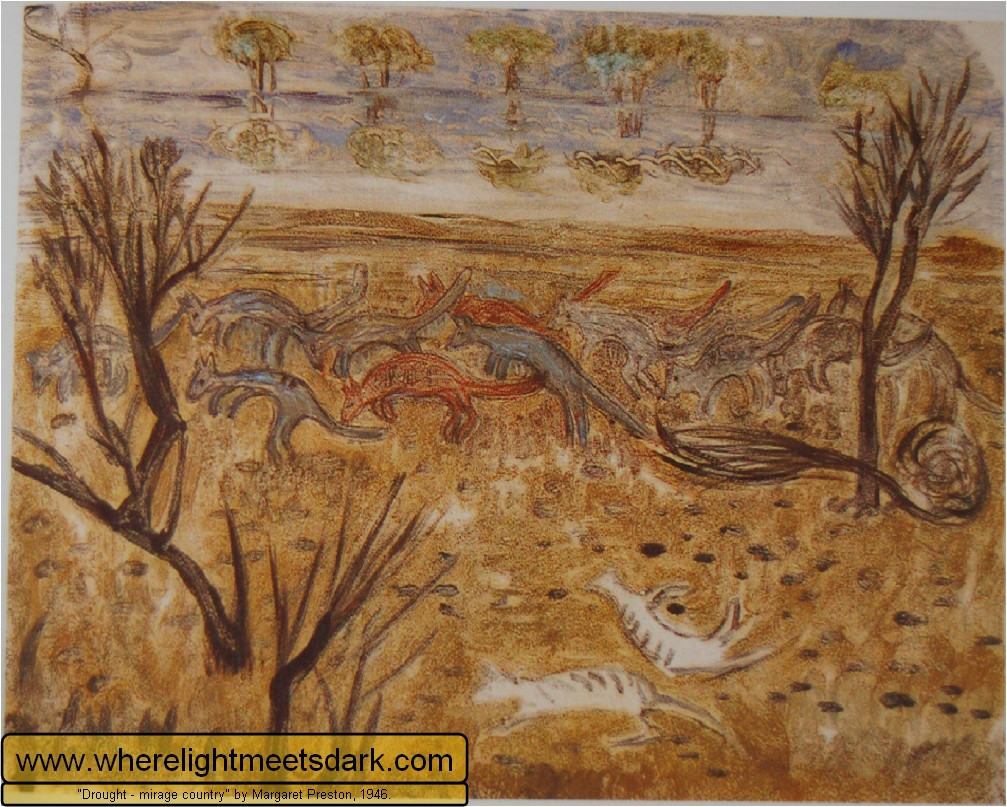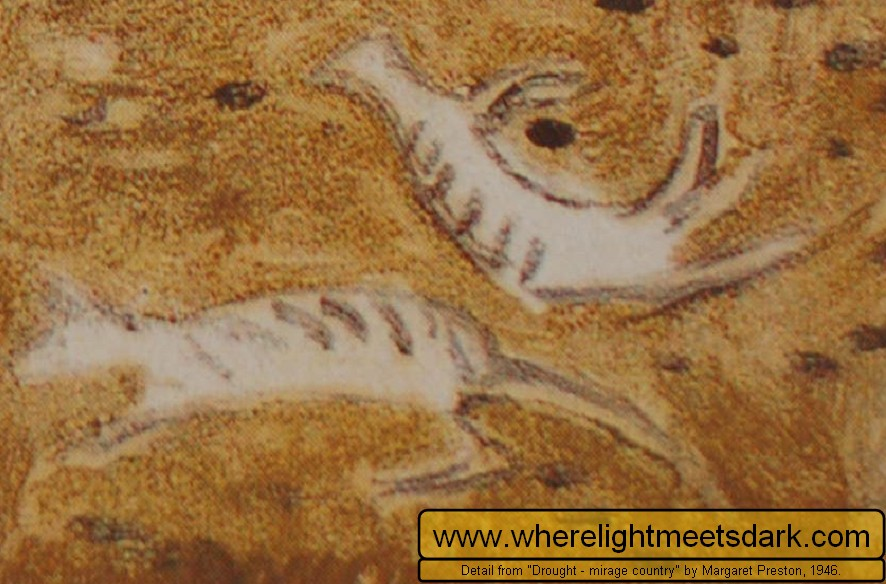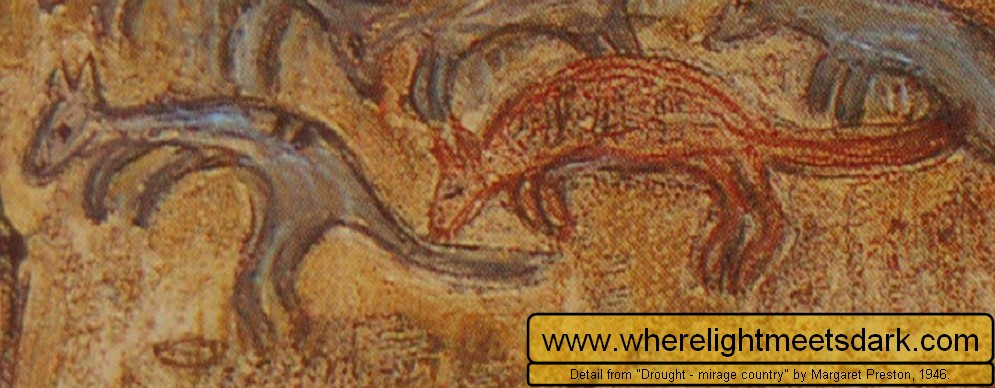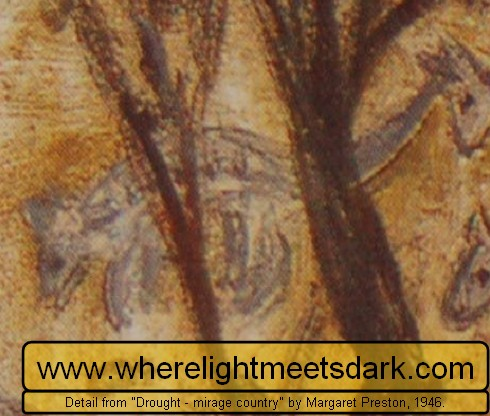Preston thylacines
Note about copyright
The images in this article are details from the artwork by Margaret Preston titled "Drought - mirage country 1946". They are reproduced with the knowledge of the Licensing Manager (VISCOPY) under the defence of criticism and review.
Mainland Tasmanian tigers - in 1946?
Let me say up-front that it is extremely unlikely Margaret Preston included two thylacines in her artwork "Drought - Mirage Country 1946", but the monotype is an interesting one. This work first caught my attention as a child, as it appears in the two volume book titled "My Country - Australian Poetry and Short Stories Two Hundred Years".
There, in the foreground are what appears to be two thylacines - or Tasmanian tigers - at least one of them dead although probably both. The title gives away their plight: Drought. But scampering through the rear of the scene are numerous wallabies or kangaroos all stylistically distinct, but clearly macropods.
Are they thylacines?
Although the wallabies in the background are not photo-realistic, they show clear similarities between each other. Their main features of course are their heads, hind legs, forepaws and tails. Most have distinct, tall ears. As we look to the recently deceased laying in the foreground, a number of features do stand out as being different. First, and most obviously, they are striped.
Are these thylacine stripes, or the ridges of ribs showing through emaciated skin? There is clearly not the detail to make any distinction, but there are other differences between these two animals and the living in the background. Next is the colouration - a sandy tan and white fur. Is this the colour of the coat of mainland Tasmanian tigers ten years after their accepted extinction, or the colour of sun-parched kangaroo hide, bleached and leathery stiff?
Finally, there are some smaller differences but nonetheless distinct. In particular, the lower animal has a very unusual rump which seems to gracefully curve downwards until reaching the tail which juts out at right angles. Is this a representation of a carnivorous quadruped's hind quarters, or simply a limitation of the medium? Was Preston being so careful to be accurate? The ears of these two animals are also not as distinct as most of the wallabies, but then, subtitled "mirage country", are these two creatures also wallabies, fading out of existence in a land itself barely shimmering in and out of being real?
Striped kangaroos?
A closer examination reveals one very troubling feature for those who would like to think that these are thylacines laying in the sun. Three of the very-clearly-wallabies have striped rumps. Not immediately visible at first, the features are nonetheless there. Could these be the protruding ribs of the animals about to join their cousins in death? Most likely. Although there certainly are wallaby species which have striped patterns (such as the yellow-footed rock wallaby), none have transverse stripes as shown here.
It may be almost as realistic to propose that Preston sighted a hitherto undescribed species of wallaby in the Australian outback. Once again, this is probably stretching the story that this artwork paints just a little too far.
South Australia
As explained in the beginning, I think it highly unlikely Margaret Preston saw thylacines dead in the outback in 1946. The notion of there being thylacines on the mainland is at least very marginally plausible. As discussed in other articles on this website, Robert Paddle in his book The Last Tasmanian Tiger describes at least 4 references to mainland thylacines surviving until the 1830s. Two of these came from South Australia in an area to the north of where numerous sightings were made in the 1960s and 1970s, including Liz and Gary Doyle's film footage of 1973.
Preston's work now resides at the Queensland Art Gallery and I have received assistance in tracing this work's history from same. From the work's catalogue essay, its exhibition history reads "'The art of Margaret Preston', Art Gallery of South Australia, Adelaide and touring to the National Gallery of Victoria, Melbourne and the Art Gallery of New South Wales, Sydney, 1980." Did this work enter galleries' collections in South Australia (as this state is listed first)? Could this be because this is where it was created? For those who enjoy thinking wishfully from time to time it's a tantalising detail of coincidence.
Art Gallery Catalogue Essay
Further details about the techniques involved in creating the work seem to give away the real reason why the two foreground animals appear so markedly different than the others: "Of the eight Margaret Preston monotypes which the Queensland Art Gallery holds, Drought - mirage country 1946, provides a clear illustration of Preston's monotype technique. The major part of the image has been brushed onto the printing surface using several coloured and one black printing ink. The birds wheeling just above the horizon have been scraped back, while other areas of the image (for example the two kangaroos in the foreground) have been achieved by leaving blank a portion of the printing surface. The impression was later 'reinforced' with the addition of pigment brushed directly onto the image."
Here the animals are clearly referred to as kangaroos and they were created in a manner entirely different to the rest of the image.
Margaret Preston's own words
The catalogue essay contains comments on this artwork from Margaret Preston herself, cited from Margaret Preston's monotypes, 1949, opp. pl. 25, Smith, Sydney Ure (ed).
Commenting in 1949, Preston said "This was made from the memory of a trip into the back country when it was drought-stricken. The parched land bred mirages of phantom trees in blue water, trees were reflected in it. The earth was yellow and gaunt. Black trees and stones littered the land. Thirst-stricken kangaroos weakly jumped by. Only the mirage was gay. The technique has been made as arid as possible, in sympathy with the subject."
Once again, kangaroos are the only animals mentioned.
Conclusion
Mainland Tasmanian tigers in 1946? Doubtful, but an interesting artwork nonetheless!



